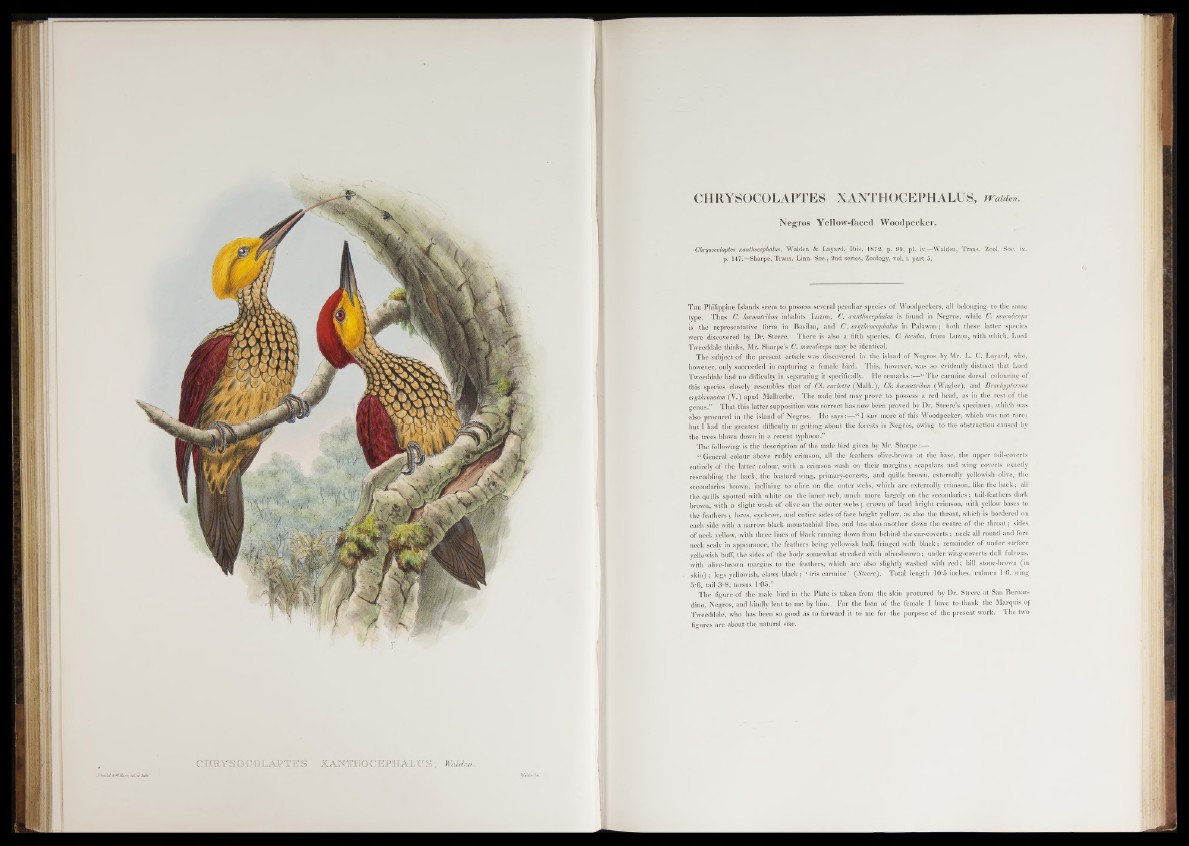
CHRYSOCOLAPTES XATTTJBtO CEPHAJL ¡US , — I
CHRYSOCOLAPTES XANTHOCEPHALUS, M i
Negros Yellow-faced Woodpecker.
Chrysocolaptes xanthocephalus, Walden & Layard^ Ibis, 1872, p. 99, pi. iv.—Walden, Trans. Zool. Soc. ix.
p. 147.—Sharpe, Trans. Linn. Soc., 2nd series, Zoology, vol. i. part 5.
T he Philippine Islands seem to possess several peculiar species of Woodpeckers, all belonging to the same
type. Thus C. hcematribon inhabits Luzon, C. xanthocephalus is. found in Negros, while C. maculiceps
is the representative form in Basilan, and C . erythrocephalus in Palawan; both these latter species
were discovered by Dr. Steere. There is also a fifth species, C. lucidus, from Luzon, with which, Lord
Tweeddale thinks, Mr. Sharpe’s C. maculiceps may be identical.
The subject of the present article was discovered in the island of Negros by Mr. L. C. Layard, who,
however, only succeeded in capturing a female bird. This, however, was so evidently distinct that Lord
Tweeddale had no difficulty in separating it specifically. He remarks : - g | The carmine dorsal colouring of
this species closely resembles that of Ch. carlotta (Malh.), Ch. hcematribon (Wagler), and Brachypternus
erythronotus (V.) apud Malherbe. The male bird may prove to possess a red head, as in the rest of the
genus.’’ That this latter supposition was correct has now been proved by Dr. Steere’s specimen, which was
also procured in the island of Negros. He says : - 3 ‘ I saw more of this Woodpecker, which was not rare;
but I had the greatest difficulty in getting about the forests in Negros, owing to the obstruction caused by
the trees blown down in a recent typhoon.”
The following is the description of the male bird given by Mr. Sharpe :—
“ General colour above ruddy crimson, all the feathers olive-brown at the base, the upper tail-coverts
entirely of the latter colour, with a crimson wash on their margins; scapulars and wing coverts exactly
resembling the back, the bastard wing, primary-coverts, and quills brown, externally yellowish olive, the
secondaries brown, inclining to olive on the outer webs, which are externally crimson, like the back; all
the quills spotted with white on the inner web, rnnch more largely on the secondaries; tail-feathers dark
brown, with a slight wash of olive on the outer webs; crown of head bright crimson, with yellow bases to
the feathers; lores, eyebrow, and entire sides of face bright yellow, as also the throat, which is bordered on
each side with a narrow black moustachial line, and has also another down the centre of the throat; sides
of neck yellow, with three lines of black running down from behind the ear-coverts; neck all round and fore
neck scaly in appearance, the feathers being yellowish buff, fringed with black; remainder of under surface
yellowish buff, the sides o f the body somewhat streaked with olive-brown; under wing-coverts dull fulvous,
with olive-brown margins to the feathers, which are also slightly washed with red; bill stone-brown (in
skiu); legs yellowish, claws black; ‘ iris carmine’ (Steere). Total length 10*5 inches, culmen 1'6, wing
5 -6, tail 3 ‘8, tarsus 1'05.”
The figure o f the male bird in the Plate is taken from the skin procured by Dr. Steere at San Bernardino,
Negros, and kindly lent to me by him. For the loan of the female I have to thank the Marquis of
Tweeddale, who has been so good as to forward it to me for the purpose of the present work. The two
figures are about the natural size.